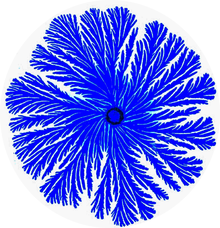Paenibacillus dendritiformis
| Paenibacillus dendritiformis | |
|---|---|
 |
|
| Figure 1: A colony generated by the Branching (Tip splitting) morphotype bacteria of P. dendritiformis. The colony diameter is 6cm and the colors indicate the bacteria density (darker shade for higher density). | |
| Scientific classification | |
| Domain: | Bacteria |
| Phylum: | Firmicutes |
| Class: | Bacilli |
| Order: | Bacillales |
| Family: | Paenibacillaceae |
| Genus: | Paenibacillus |
| Species: | P. dendritiformis |
| Binomial name | |
|
Paenibacillus dendritiformis (Ash et al., 1994) |
|
| Synonyms | |
|
Bacillus dendritiformis
Ash et al. 1994 |
|
Paenibacillus dendritiformis is a species of pattern-forming bacteria, first discovered in the early 90s by Ben-Jacob's group. It is a social microorganism that forms colonies with complex and dynamic architectures. The genus Paenibacillus comprises facultative anaerobic, endospore-forming bacteria originally included within the genus Bacillus and then reclassified as a separate genus in 1993. Bacteria belonging to this genus have been detected in a variety of environments such as: soil, water, rhizosphere, vegetable matter, forage and insect larvae.
In recent years there is an increasing interest in studies of Paenibacillus spp. since many were found to be important for industrial, agricultural and medical applications. These bacteria produce various extracellular enzymes such as polysaccharide-degrading enzymes and proteases, which can catalyze a wide variety of synthetic reactions in fields ranging from cosmetics to biofuel production. Various Paenibacillus spp. also produce antimicrobial substances that affect a wide spectrum of micro-organisms such as fungi, soil bacteria, plant pathogenic bacteria and even important anaerobic pathogens as Clostridium botulinium.
P. dendritiformis is a social microorganism: when grown under growth conditions that mimic natural environments such as hard surfaces, it forms colonies of 109-1012 cells with remarkably complex and dynamic architectures (Figure 1). Being part of a large cooperative, the bacteria can better compete for food resources and be protected against antibacterial assaults. The P. dendritiformis exhibit many distinct physiological and genetic traits including β-galactosidase-like activity causing colonies to turn blue on X-gal plates and multiple drug resistance (MDR) (including septrin, penicillin, kanamycin, chloramphenicol, ampicillin, tetracycline, spectinomycin, streptomycin and mitomycin C. Colonies that are grown on surfaces in Petri dishes exhibit several folds higher drug resistance in comparison to growth in liquid media. This particular resistance is believed to be due to a surfactant-like liquid front that actually forms a particular pattern on the Petri plate.
...
Wikipedia
